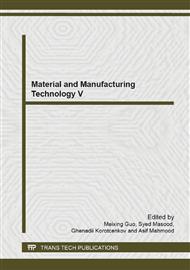p.3
p.9
p.15
p.20
p.26
p.33
p.38
p.43
Effect of Catalyst Concentration on Performance of Hybrid CNT-Carbon Fibre Nanocomposite
Abstract:
In this research, the CNT coating treatment process involves the growth of CNTs onto the surface of the carbon fibre by floating catalyst techniques using CVD. The amount of ferrocene concentration has been varied throughout this study. Different morphologies of structured CNTs through TEM instruments are discussed and the analysis study of the composition of the coated carbon fibres by the growth of CNTs using EDX is also explained. In the present study, various ferrocene concentration gives a greatest influenced to the structure of CNT growth on carbon fibre surface. Lower ferrocene concentration favoured the growth of CNTs meanwhile higher catalyst amount lead to catalyst poisoning effect which resulting lower tensile strength of the hybrid CNT-carbon fibre nanocomposite structure.
Info:
Periodical:
Pages:
15-19
Citation:
Online since:
June 2014
Authors:
Price:
Сopyright:
© 2014 Trans Tech Publications Ltd. All Rights Reserved
Share:
Citation:


